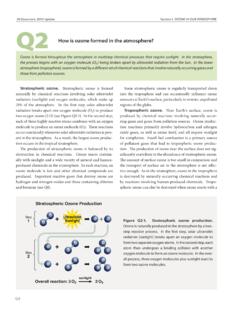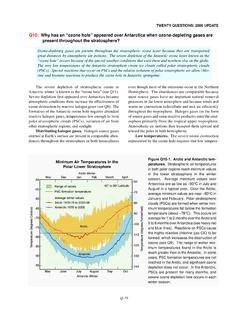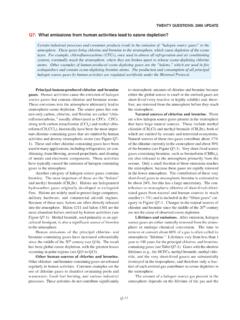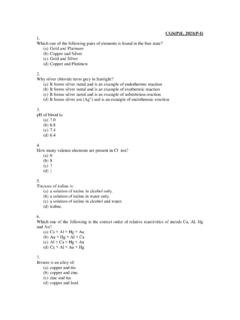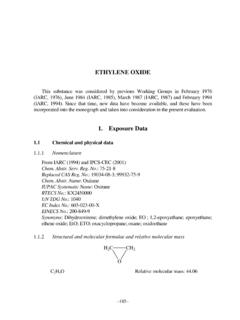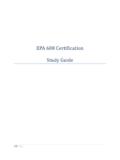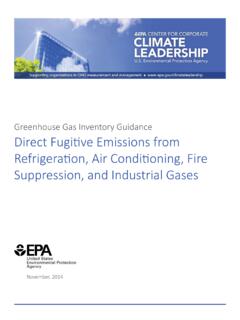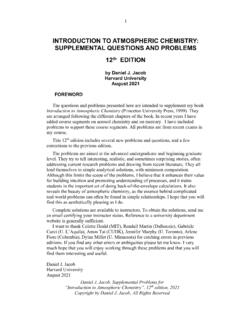Transcription of Why has an “ozone hole” appeared over Antarctica when …
1 S ection II: The ozone depletion process 33 Why has an ozone hole appeared over Antarctica when ozone -depleting substances are present throughout the stratosphere? ozone -depleting substances are present throughout the stratospheric ozone layer because they are transported great distances by atmospheric air motions. The severe depletion of the Antarctic ozone layer known as the ozone hole occurs because of the special meteorological and chemical conditions that exist there and nowhere else on the globe. The very low winter temperatures in the Antarctic stratosphere cause polar stratospheric clouds (PSCs) to form. Special reactions that occur on PSCs, combined with the isolation of polar stratospheric air in the polar vortex, allow chlorine and bromine reactions to produce the ozone hole in Antarctic severe depletion of stratospheric ozone in late winter and early spring in the Antarctic is known as the ozone hole (see Q11).
2 The ozone hole appears over Antarctica because meteorological and chemical conditions unique to this region increase the effectiveness of ozone destruction by reactive halogen gases (see Q8). In addition to an abundance of these reactive gases, the formation of the Antarctic -60-70-80-90-100-110-120-130-140 Temperature (degrees Fahrenheit)Antarctic winterMayJuneJulyAugustSeptOctArctic winterMinimum Air Temperatures in the Polar StratosphereNovDecJanFebMarchApril-50-55 -60-65-70-75-80-85-90-95 Temperature (degrees Celsius)Antarctic 1979 to 2013 Arctic 1979/80 to 2013/14 Average daily valuesPSC formation temperatureRanges of daily valuesArcticAntarctic(40 to 90 latitude)Figure Q10-1. Arctic and Antarctic temperatures. Air temperatures in both polar regions reach minimum values in the lower stratosphere in the winter season. Average daily minimum values over Antarctica are as low as 90 C in July and August in a typical year.
3 Over the Arctic, average minimum values are near 80 C in late December and January. Polar stratospheric clouds (PSCs) are formed in the polar ozone layer when winter minimum temperatures fall below the formation temperature of about 78 C. This occurs on average for 1 to 2 months over the Arctic and 5 to 6 months over Antarctica (see heavy red and blue lines). Reactions on liquid and solid PSC particles cause the highly reactive chlorine gas ClO to be formed, which catalytically destroys ozone (see Q9). The range of winter minimum temperatures found in the Arctic is much greater than in the Antarctic. In some years, PSC formation temperatures are not reached in the Arctic, and significant ozone depletion does not occur. In contrast, PSC formation temperatures are always present for many months somewhere in the Antarctic, and severe ozone depletion now occurs in each winter season (see Q11).
4 (Note that the dashed black lines denote the upper limits of the Antarctic temperature range where they overlap with the Arctic temperature range.)10 Minimum Air Temperatures in the Polar Stratosphere34 Section II: The ozone depletion processozone hole requires temperatures low enough to form polar stratospheric clouds (PSCs), isolation from air in other stratospheric regions, and of halogen gases. Halogen source gases that are emitted at Earth s surface and have lifetimes longer than about 1 year are present in comparable abundances throughout the stratosphere in both hemispheres, even though most of the emissions occur in the Northern Hemisphere. The abundances are comparable because most long-lived source gases have no significant natural removal processes in the lower atmosphere, and because winds and convection redistribute and mix air efficiently throughout the troposphere on the timescale of weeks to months.
5 Halogen gases (in the form of source gases and some reactive products) enter the stratosphere primarily from the tropical upper troposphere. stratospheric air motions then transport these gases upward and toward the pole in both polar temperatures. The severe ozone destruction that leads to the ozone hole requires low temperatures to be present over a range of stratospheric altitudes, over large geographical regions, and for extended time periods. Low temperatures are important because they allow liquid and solid PSCs to form. Reactions on the surfaces of these PSCs initiate a remarkable increase in the most reactive chlorine gas, chlorine monoxide (ClO) (see below and Q8). stratospheric temperatures are lowest in the polar regions in winter. In the Antarctic winter, minimum daily temperatures are generally much lower and less variable than those in the Arctic winter (see Figure Q10-1).
6 Antarctic temperatures also remain below PSC formation temperatures for much longer periods during winter. These and other meteorological differences occur because of the differences in the distribution of land, ocean, and mountains between the hemispheres at middle and high latitudes. Winter temperatures are low enough for PSCs to form somewhere in the Antarctic for nearly the entire winter (about 5 months), but only for limited periods (10 60 days) in the Arctic in most conditions. stratospheric air in the polar regions is relatively isolated for long periods in the winter months. The isolation is provided by strong winds that encircle the poles during winter, forming a polar vortex, which prevents substantial transport and mixing of air into or out of the polar stratosphere. This circulation strengthens in winter as stratospheric temperatures decrease. Since winter temperatures are lower in the Southern than in the Northern Hemisphere polar stratosphere, the isolation of air in the vortex is much more effective in the Antarctic than in the Arctic.
7 Once temperatures drop low enough, PSCs form within the polar vortex and induce chemical changes that are preserved by the isolation for many weeks to stratospheric clouds (PSCs). Reactions on the surfaces of liquid and solid PSCs can substantially increase the relative abundances of the most reactive chlorine gases. These reactions convert the reservoir forms of reactive chlorine gases, chlorine nitrate (ClONO2) and hydrogen chloride (HCl), to the most reactive form, ClO (see Figure Q8-1). ClO increases from a small fraction of available reactive chlorine to comprise nearly all chlorine that is available. With increased ClO, the catalytic cycles involving ClO and BrO become active in the chemical destruction of ozone whenever sunlight is available (see Q9).Different types of liquid and solid PSC particles form when stratospheric temperatures fall below about 78 C ( 108 F) in polar regions (see Figure Q10-1).
8 As a result, PSCs are often found over large areas of the winter polar regions and over significant altitude ranges, with larger regions and for longer time periods in the Antarctic than in the Arctic. The most common type of PSC forms from nitric acid (HNO3) and water condensing on pre-existing liquid sulfuric acid-containing particles. Some of these particles freeze to form solid particles. At even lower temperatures 10 S ection II: The ozone depletion process 35( 85 C or 121 F), water condenses to form ice particles. PSC particles grow large enough and are numerous enough that cloud-like features can be observed from the ground under certain conditions, particularly when the Sun is near the horizon (see Figure Q10-2). PSCs are often found near mountain ranges in polar regions because the motion of air over the mountains can cause localized cooling in the stratosphere, which increases condensation of water and average temperatures begin increasing by late winter, PSCs form less frequently and conversion reactions on their surfaces produce less ClO.
9 Without continued ClO production, ClO amounts decrease and other chemical reactions re-form the reservoirs gases, ClONO2 and HCl. When temperatures rise above PSC formation thresholds, which typically occurs by late January to early February in the Arctic or by mid-October in the Antarctic, the most intense period of ozone depletion acid and water removal. Once formed, PSC particles fall to lower altitudes because of gravity. The largest particles can descend several kilometers or more in the stratosphere within a few days during the low-temperature winter/spring period. Because PSCs often contain a significant fraction of available HNO3, their descent removes HNO3 from regions of the ozone layer. This process is called denitrification of the stratosphere. Because HNO3 is a source for nitrogen oxides (NOx) in the stratosphere, denitrification removes the NOx available for converting the highly reactive chlorine gas ClO back into the reservoir gas ClONO2.
10 As a result, ClO remains chemically active for a longer period, thereby increasing chemical ozone destruction. Significant denitrification occurs each winter in the Antarctic but only in occasional winters in the Arctic, because PSC formation temperatures must be sustained over an extensive altitude region and time period to lead to denitrification (see Figure Q10-1).Ice particles form at temperatures that are a few degrees lower than those required for PSC formation from HNO3. If ice particles grow large enough, they can fall several kilometers due to gravity. As a result, a significant fraction of water vapor can be removed from regions of the ozone layer over the course of a winter. This process is called dehydration of the stratosphere. Because of the very low temperatures required to form ice, dehydration is common in Antarctic but rare in Arctic winters. The removal of water vapor does not directly affect the catalytic reactions that destroy ozone .
